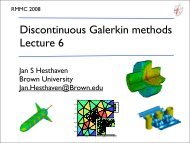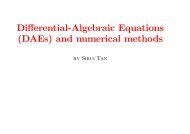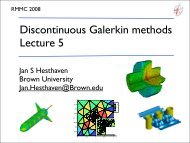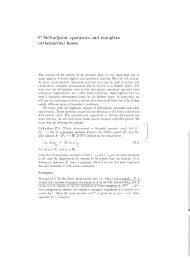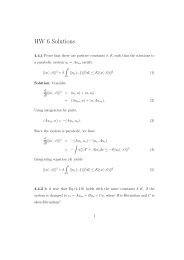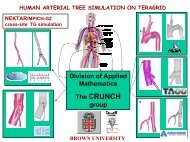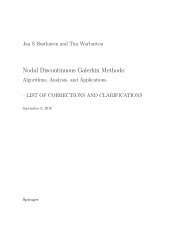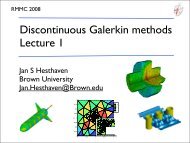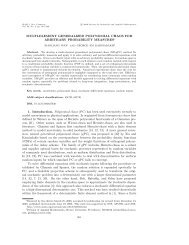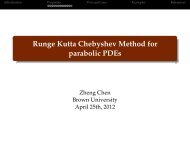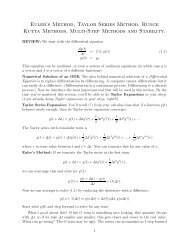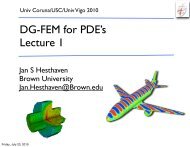APMA2560 Homework #3 Solutions
APMA2560 Homework #3 Solutions
APMA2560 Homework #3 Solutions
You also want an ePaper? Increase the reach of your titles
YUMPU automatically turns print PDFs into web optimized ePapers that Google loves.
<strong>APMA2560</strong><strong>Homework</strong><strong>#3</strong><strong>Solutions</strong><br />
1.)ConsiderthediscreteexpansionFebruary23,2008<br />
uN(x)=X jnjN/2u~nexp(inx); xj=2Nj;j=0;1;N?1; u~n=1 cnNXj=0 N?1u(xj)exp(?inxj);<br />
withcn=1forjnj
gj(x).Wenowshowthatthegj(x)areLagrangefunctions.Wehave gj(xj)=1NX<br />
=1NX jnjN/21<br />
jnjN/21 cnein(xj?xj)<br />
=1N0@"X jnjN/21#?11A c n<br />
Forxlxj,wehave gj(xl)= jnjN/21 XNcnein2(l?j)/N<br />
=1:<br />
=?1Ncos((l?j))+e?i2(l?j)N/(2N) =?1 2Nei2(l?j)N/(2N)+e?i2(l?j)N/(2N)+1NX jnjN/2ein2(l?j)/N<br />
N Xn=0 Nei2n(l?j)/Nn<br />
=?1Ncos((l?j))+cos((l?j))<br />
1?ei2(N+1)(l?j)/N<br />
N 1?ei2(l?j)/N 1?ei2(l?j)/N<br />
b)Inordertoderiveanexplicitformforthederivative,weuseequation(1): =0:<br />
dxuN(xi)=24d d dxXj=0 N?1u(xj)1NX jnjN/21<br />
=Xj=0 N?1u(xj)1NX jnjN/2in cnein(xi?xj); cnein(x?xj)35x=xi<br />
Thuswecandeneentriesofthedierentiationmatrixas<br />
Thatthismatrixisskew-symmetriccanbeshown: Dij=1NX<br />
Dji=1NX jnjN/2?in cnein(xi?xj):<br />
=?1NX jnjN/2in cne?in(xj?xi)<br />
=?Dij: cnein(xi?xj)
ForittobeToeplitz,wehave,foralli;j
NNwithNeven,thenthefactthatDhasonezeroeigenvalueimpliesthatithasat forn0.Actually,sincewe'veshownthatDisaskew-symmetricmatrix,andsinceitis leasttwozeroeigenvalues.(Ormoregenerally,thatishasanevennumberofzeroeigenvalues.)<br />
2.)Considerthefollowingapproximationtotheintegral<br />
a)Ifwedenethespaceoftrigonometricfunctions 2Z02u(x)dx'1 1 N+1Xj=0 Nu(xj); xj=2j N+1;j=0;1;N:<br />
b)Conrmtheanalyticresultbycomputationsbychoosingu(x)toillustratetheaccuracy provethattheapproximationisexactforallu(x)2B2N. BN=spanfexp(inx)gjnjN/2;<br />
Solution: andfailureoftheapproximation.<br />
a)Itissucienttoshowthat1 foralljnjN.Forn=0: N+1Xj=0 Neinxj=1 2Z02einxdx=n;0;<br />
Forn0,jnjN:1 N+1Xj=0 1 Nei0xj=1<br />
N+1Xj=0 Neinxj= N+1Xj=0<br />
Nei2nj/(N+1)<br />
= N+1 1 1?ei2n(N+1)/(N+1) 1?ei2n/(N+1) !<br />
foreverynexceptn=j(N+1),j2Znf0g.Theresultsfrompartbconrmthis. Notethattheaboveresultalsoshowsthatthisquadratureruleintegrateseinxcorrectly =0<br />
b)Weillustratetheexpectedaccuracyinthisproblem.Firstwedene<br />
and IN(f)=1 I(f)=1 2Z02f(x)dx;<br />
N+1Xj=0 Nf(xj);
10 0 Error in Fourier quadrature with N = 44<br />
∣ ∣I<br />
44(e inx ) - I(e inx ) ∣ ∣<br />
10 −5<br />
10 −10<br />
astheexactintegralandapproximatequadrature,respectively.Wetake,fornoparticularlygoodreason,N=44andplottheabsoluteerrorbetweenI(f)andI44(f)ingure<br />
quadraturetofailforn=45;90;135;:(Andinparticular,weexpectthequadraturetobeexactforalljnj44.)Inthegure,weseethisbehaviorforthepositiven.<br />
Theerrorspikesatn=45;90;135;:Bylinearity,wecanthenconcludethatI44(f)= 1.WetakefunctionstobeFourierbasisfunctionseinx.Notethatweonlyexpectthe<br />
haveto:foranyn0: I(f)foreveryf2B88(accuratetomachineprecision). Ofcourse,wehavenottakenintoaccountnnegative,butweclaimthatwedon't Ie?ijnjx?INe?ijnjx =0?1 =0?INe?ijnjx N+1Xj=0 Ne?ijnjx (jjisinvariantundercomplexconjugation)=0?1 N+1Xj=0 Ne+ijnjx<br />
Therefore,weneedonlyexploretheerrorforpositiven. =Ieijnjx?INeijnjx:<br />
Figure1.Errorinthequadratureruleforan(N+1)-pointFourierquadraturerule.TheintegratedfunctionsarethebasisfunctionsfortheFourierspace,einx.WetakeN=44here.<br />
10 −15<br />
0 50 100 150 200 250 300 350 400<br />
n
3.)Considerthefollowingfunction<br />
Weshallexplorewaysofcomputingthederivativesofu(x)usingthecontinuousanddiscrete u(x)= 5?4cos(x);x2[0;2]: 3<br />
expansioncoecientsaswellasthedierentiationmatrix. (b)Usingtheexactcontinuousexpansioncoecients (a)Computetheanalyticderivativesofu(x)ofupto4thorder,i.e.u(m);m=1;2;3;4.<br />
computethemaxerrorofuN(m)form=1,2,3,4andforN=2p;p=2?10:Tabulatetheresultsand discusswhatyousee. u^n=2?jnj;<br />
discussedabove.ComputethemaxerrorofuN(m)form=1,2,3,4andforN=2p;p=2?10.Tabulatetheresultsanddiscusswhatyousee,inparticularinrelationtotheresultsintheprevious<br />
(c)Nowrepeatthisexercisebutusethediscreteexpansioncoecientsfortheevenexpansion questions.<br />
andtheirsources,ifyouobserveanysubstantialdierences. forN=2p;p=2?10andcomparewiththeresultsinthetwopreviouscases. (e)Discussanysubstantialdierencesbetweenthe3casesandtrytoexplainthedierences (d)Finally,usethedierentiationmatrixDderivedabovetocomputeuN(m)form=1;2;3;4<br />
Solution: a)Thederivativesare<br />
u(2)(x)=12(?6+5cos(x)+2cos(2x)) u(1)(x)=? (5?4cos(x))2 12sin(x)<br />
u(3)(x)=12[?63+80cos(x)+8cos(2x)]sin(x) (5?4cos(x))3<br />
u(4)(x)=12(670?815cos(x)?58cos(2x)+220cos(3x)+8cos(4x)) (5?4cos(x))4<br />
b)Usingu^n=2?jnjwehave (5?4cos(x))5<br />
uN(m)(x)=X<br />
cision.Notethatthelimitofprecisionincreasesform;thiscorrespondstothelossofaccuracy Fromthisweobservespectralconvergenceoftheerroruntilp=7,atwhichwehitmachinepre-<br />
jnjN/2(in)m2?jnjexp(inx)<br />
incurredbythe(in)mmultiplication. 2p5.2000e-019.0000e+002.3632e+002.9100e+02<br />
u(1) u(2) u(3) u(4)
3456 0.4381e+004.7500e+001.1934e+012.3875e+02<br />
7 4.7731e-027.9688e-015.2155e+008.9671e+01<br />
8 3.6038e-049.9487e-031.1427e-013.3366e+00<br />
9 1.0444e-085.3924e-071.1932e-056.2914e-04<br />
100.3997e-140.1599e-130.6395e-130.1904e-11 0.1998e-140.8882e-140.4974e-130.1604e-11 0.2665e-140.8882e-140.6395e-130.1904e-11 0.3997e-140.1421e-130.6395e-130.1904e-11<br />
Error using continuous coefficients<br />
10 5 N<br />
10 0<br />
u (1)<br />
u (2)<br />
u (3)<br />
u (4)<br />
L ∞<br />
−error<br />
10 −5<br />
10 −10<br />
c)Oncewesolveforthediscretecoecientsu~nwemayevaluatethedesiredderivativesas uN(m)(x)=X<br />
10 −15<br />
jnjN/2(in)mu~nexp(inx)<br />
0 200 400 600 800 1000 1200<br />
canseethattheerrorforthediscretecoecientsishigherthanthatofthecontinuouscoecients.Thisisaresultofthealiasingerrorintroducedbyusingthediscretecoecients.The<br />
erroralsobeginstoincreaseafterreachingitslowestpoint(againcorrespondingtop=7).This Againwenoteaspectralconvergenceinerror,althoughcomparingtheresultsfrom(b)one<br />
usingthe(inexact)discretecoecientsu~n. isknownasniteprecisioneectsandiscausedbytheamplicationofround-oerrorwhen<br />
234p 0.8533e+008.5333e+002.6965e+002.9013e+02 0.6538e+004.0157e+001.3431e+012.3291e+02 0.8141e-010.5000e+006.1779e+007.7001e+01 u(1) u(2) u(3) u(4)<br />
5678 0.6482e-030.3906e-020.1726e+002.1016e+00<br />
9 0.1982e-070.1192e-060.2046e-040.2472e-03<br />
100.1860e-090.8976e-070.3313e-040.1534e-01 0.2736e-110.1209e-090.7106e-080.3747e-06 0.7855e-100.8399e-090.7324e-070.9758e-05 0.4445e-100.1566e-070.2283e-050.8005e-03
Error using discrete coefficients<br />
10 5 N<br />
10 0<br />
u (1)<br />
u (2)<br />
u (3)<br />
u (4)<br />
L ∞<br />
−error<br />
10 −5<br />
10 −10<br />
Tobetterillustratetheniteprecisioneects,wecanexaminethenumericalrepresentation<br />
10 −15<br />
0 200 400 600 800 1000 1200<br />
areonlyabletoberesolveduptomachinezero. thatthecontinuouscoecientsareabletobeexactlyrepresentedwhereasthethediscreteones ofthediscretecoecientsu~nandcontinuouscoecientsu^n=2?jnj.Asseenbelow,wenote<br />
coefficients for p=8 case<br />
discrete coefficients<br />
continuous coefficients<br />
10 −10<br />
c n<br />
10 −20<br />
10 −30<br />
10 0<br />
d)HereweusethedierentiationmatrixDfromquestion(1b),taking<br />
10 −40<br />
−150 −100 −50<br />
uN(m)=DmuN<br />
0 50 100 150<br />
n<br />
whereuNisthearrayfu(xj)g;j=0;:;N?1
derivativesfor(c)and(d)havethesameerror. reasonsas(c).Onenotesthatuptothep=7thresholdofmachineprecision,the1stand3rd Theresultsareverysimilartothosefoundinpart(c),anddierwithpart(b)forthesame<br />
32p 0.6538e+006.0235e+001.3431e+012.6504e+02 0.8533e+001.0667e+012.6965e+002.9867e+02 u(1) u(2) u(3) u(4)<br />
4567 0.8141e-011.0000e+006.1779e+001.0900e+02 0.6482e-030.1172e-010.1726e+004.1016e+00<br />
98 0.1982e-070.5960e-060.2046e-040.7355e-03<br />
10 0.6029e-100.3920e-070.1034e-040.7024e-02 0.8860e-120.4260e-100.2283e-080.1270e-06 0.1923e-100.7623e-080.1124e-050.3878e-03 0.3529e-110.2727e-090.3401e-070.2783e-05<br />
Error using differentiation matrices<br />
10 5 N<br />
10 0<br />
u (1)<br />
u (2)<br />
u (3)<br />
u (4)<br />
L ∞<br />
−error<br />
10 −5<br />
10 −10<br />
inpart(d)wearetakingthederivativeoftheinterpolant.Forexample,thesecondderivative in(c)iscomputedwiththeoperator e)Themethodusedinpart(c)correspondstotakingtheinterpolantofaderivativewhereas<br />
10 −15<br />
0 200 400<br />
D(2)=INd dx2<br />
600 800 1000 1200<br />
whereastheoperatorusedin(d)isthematrix-matrixproduct<br />
Itturnsoutthatfortheevenexpansion(i.e.thenumberofgridpointsiseven),theseoperators D2=INd2<br />
arenotequal,i.e. dx2IN;<br />
Ingeneral,foroddmtheseoperatorsarethesamewhiletheydierslightlyforevenm.Thisis observedbelow,numerically,byevaluatingthemaximumdierencebetweenthetwomethods. D(2)D2:
max difference between derivatives computed in (c) and (d)<br />
10 5 N<br />
10 0<br />
u (1)<br />
u (2)<br />
u (3)<br />
u (4)<br />
10 −5<br />
10 −10<br />
10 −15<br />
whiletheresultsform=2andm=4conrmthelackofcommutivityoftheoperators.<br />
10 −20<br />
observesthesuperioraccuracyofthecontinuousexpansionwhichisaresultofthealiasingerror Asanalcomparison,belowareplotsoftheerrorvspforthethreecases.Oneagain Again,thegrowthobservedinthem=1andm=3caseareduesolelytoroundoerrors<br />
0 50 100 150 200 250 300<br />
andniteprecisioneectsintroducedintheinterpolation.<br />
10 0 u (1)<br />
10 20 u (2)<br />
L ∞<br />
−error<br />
10 −10<br />
10 −20<br />
b<br />
c<br />
d<br />
2 4 6 8 10<br />
p<br />
u (3)<br />
10 20<br />
L ∞<br />
−error<br />
10 0<br />
10 −20<br />
2 4 6 8 10<br />
p<br />
u (4)<br />
10 20<br />
L ∞<br />
−error<br />
10 0<br />
L ∞<br />
−error<br />
10 0<br />
10 −20<br />
2 4 6 8 10<br />
p<br />
10 −20<br />
2 4 6 8 10<br />
p



